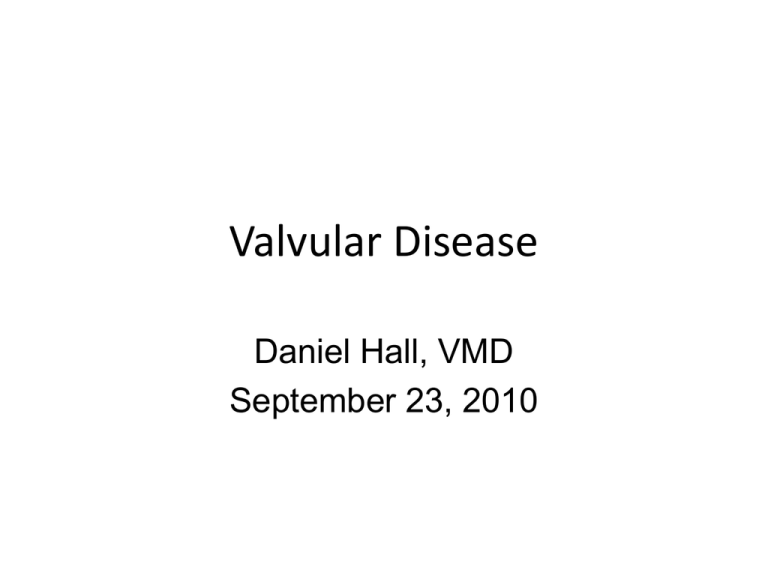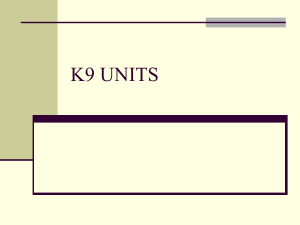Chronic Valvular Disease
advertisement

Valvular Disease Daniel Hall, VMD September 23, 2010 Valvular Disease - Outline • Pathophysiology of canine degenerative mitral valve disease (DMVD) • Literature review • Current treatment recommendations based on ACVIM Consensus Statement (2009) Degenerative Mitral Valve Disease (DMVD) • Myxomatous – No inflammatory component within valve tissue* – Genetic • Cavaliers • Dachsunds – Metabolic • Serotonin • Other mediators? – Environmental? • Carcinoid plaques Normal Mitral Valve Anatomy • Atrialis – Elastic tissue – Type I & III collagen fibers • Spongiosa – Mostly proteoglycans – Modest collagen – Valvular interstitial cells (VIC) A S F • Fibrosa – main structural layer – Dense collagen – Few elastic fibers – Extends into chordae • Ventricularis – Collagen fibers *Valvular endothelial cells cover the valve surface* V A Little More About VICs • Normally quiescent, fibroblast-like cells evenly distributed throughout valve tissue • Differentiation and activation into “active myofibroblast” cells mediated by: PDGF, TGFβ, FGF, Thrombin, Fibronectin • Active myofibroblasts cause spongiosa expansion and fibrosa destruction via expression of: Actin, collagenases, fibronectin, MMPs, chondroitin, cathepsin D, GAGs, etc. Han et al. AJVR 2008 Biomechanical Forces 1. Flexure 2. Shear In vitro studies suggest that canine VICs have receptors sensitive to tensile forces that lead to signaling involved in the pathogenesis of DMVD 3. Tension/Compression Progression of DMVD • Mild ↑ extracellular matrix (ECM) of atrialis, ↓ collagen organization of fibrosa, ↑ valvular endothelial cell proliferation • Moderate Coalescing nodules of proteoglycans & basement membrane material, further disorder/lack of fibrosa collagen • Severe ↑↑ ECM within spongiosa, disorganized fibrosa collagen, endothelial cell denuding Main changes: VIC activation, Spongiosa expansion Fibrosa [collagen] destruction, GAG infiltration Histologic Changes in DMVD A) Normal mitral valve Oyama et al. JVIM 2010 B) DMVD Initiation and Progression of Myxomatous Changes • Initiating cause(s) still unknown – Most feel initial valve injury/insult a key factor – Morphologic changes usually start at leaflet tips • Key players? – ↑ circulating 5-HT • Small dogs with CVD, CKCS without CVD – ↑ 5-HT signaling • ↑ 5-HT receptors, ↓ serotonin transmembrane transporter (SERT), ↑ tryptophan hydroxylase 1 (TPH1) expression – Other factors/pathways implicated • TGFβ, endothelin, IGF, nitric oxide – Pro-inflammatory state? - ↑ C reactive protein A Little More About 5-HT • RLS in synthesis catalyzed by THP1 • Majority of circulating 5-HT stored in dense granules of platelets • At least 5 different 5-HT receptor types in CV tissue • Elevated levels cause carcinoid syndrome (plaques) Proposed 5-HT Relation to DMVD Oyama et al. JVIM 2010 Pathophysiology What are the main factors that determine the severity of valvular regurgitation? 1. Regurgitant orifice area (ROA) 2. Transvalvular pressure gradient From the James W. Buchanan library Pathophysiology - Hemodynamics Sympathetic N.S. & RAAS activation ↑ MR + - ↓ LV SV (↓ CO) ↑ plasma volume, cardiac remodeling ↑ Preload → ↑ CO DMVD - Disease Progression Left atrial size Severe LAE CHF Mod LAE Mild LAE Normal Time (Years) Can Disease Progression Be Altered? Left atrial size Severe LAE Mod LAE Mild LAE Normal New intervention? Time (Years) Degenerative Mitral Valve Disease Clinical Syndromes • No clinical signs (asymptomatic murmur or click) • Left sided congestive heart failure (chronic LCHF) May progress to right-sided or biventricular HF secondary to development of pulmonary hypertension • Left mainstem bronchus compression by LA cough • Ruptured chordae tendinae (acute LCHF) Incidence ~15% (70% of dogs with severe CHF) • Syncope Vasovagal syncope, arrhythmias, “tussive” syncope, pulmonary hypertension • Endocardial split/LA rupture – hemopericardium, acquired atrial septal defect Clinical Assessment of DMVD Physical Exam • Mid systolic click in most • Left apical holo- or pansystolic murmur • Pulse quality – usually normal* • HR/rhythm – Sinus arrhythmia to tachycardia – Variable arrhythmias • Respiratory – Eupnic to tachypneic and/or dyspneic, +/- cough, crackles • Body condition - variable • Evidence of pulmonary hypertension/right CHF? – Loud/split S2, jugular distension, ascites – Rarely pleural/pericardial effusion Clinical Assessment Cardiac or Respiratory Dyspnea? Murmur Duration of signs Body condition HR & rhythm Lung sounds Other heart sounds BNP DMVD Respiratory ≥ III/VI Variable *usually ≤ 1 month ≥ months Normal to ↓ Normal to ↑ Sinus tachycardia Sinus arrhythmia “Do you really want to hear my answer to that?” S3 gallop? Loud/split S2? ↑↑↑ Normal to ↑ Treatment Options Depends on Disease Stage/Severity “This is a surgical disease” BJB • ACE inhibitors • Diuretics – Furosemide – Spironolactone – HCTZ, torsemide? • Pimobendan • Vasodilators – Hydralazine – Amlodipine – Nitrates • • • • • • • • • β blockers Digoxin Antiarrhythmics Sildenafil Bronchodilators Cough suppressants Tranquilizers/sedatives n-3 fatty acids AT receptor blockers? Onto some literature… Survival Characteristics and Prognostic Variables of Dogs with Mitral Regurgitation Attributable to Myxomatous Valve Disease Borgarelli et al. JVIM 2008 558 dogs with DMVD of varying severity 302 (54%) ISACHC Class I 157 (28%) ISACHC Class II 99 (18%) ISACHC Class III 33 mo. 28 mo. 9 mo. All cause mortality 9 mo. Cardiac related deaths Borgarelli et al continued. Negative Prognostic Indicators All cause mortality Age Dyspnea Furosemide Rx Cardiac-related deaths Age Dyspnea Furosemide Rx Syncope Arrhythmia ESV-I > 30 mL/m2 HR > 140 ISACHC Class LA/Ao > 1.7 MV Evel > 1.2 m/s E Syncope Arrhythmia ESV-I > 30 mL/m2 MV Evel > 1.2 m/s HR > 140 ISACHC Class LA/Ao > 1.7 EDV-I > 100 mL/m2 Overall, multivariate analysis: Syncope LA/Ao > 1.7 A MV Evel > 1.2 m/s Decreased Systolic Function and Inadequate Hypertrophy in Large and Small Breed Dogs with Chronic Mitral Valve Insufficiency (CMVI) Borgarelli et al. JVIM 2007 • Examined indices of LV diameter, contractile function and wall thickness in: – Small and large breed normal dogs – Small and large breed dogs with CMVI and CHF • Small and large breed dogs with CMVI and CHF had evidence of systolic dysfunction, possibly secondary to inadequate LV hypertrophy Fractional shortening ESVI (ml/m2) ESD/ESDe Normal SB 40.1% 21.2 0.89 CMVI SB 45.6% 30.0 1.11 Relative wall thickness 0.53 0.41 Normal LB CMVI LB 27.3% 33.6% 36.4 83.2 1.13 1.30 0.47 0.38 All differences were significant (P < 0.05) ESVI = end systolic volume index. ESD = end systolic diameter. ESDe = expected end diastolic diameter for weight. Relative wall thickness = LV free wall thickness/LV diameter in diastole. Serum Serotonin Concentrations in Dogs with Degenerative Mitral Valve Disease Arndt et al. JVIM 2009 Serum 5-HT concentration higher in dogs with DMVD, dogs predisposed to DMVD, CKCS predisposed to DMVD C-Reactive Protein Concentration in Dogs with Chronic Valvular Disease Rush et al. JVIM 2006 C-reactive protein concentration higher in dogs with DMVD compared to healthy controls; no relation to CHF or murmur grade P < 0.001 P = 0.49 Chordae Tendineae Rupture in Dogs with Degenerative Mitral Valve Disease: Prevalence, Survival, and Prognostic Factors (114 Cases, 2001–2006) Serres et al. JVIM 2007 • MST 425 days • 58% survival > 1 yr • Negative prognostic indicators: – – – – – – ISACHC class Ascites Dyspnea HR BUN LA size Doppler Echocardiography–Derived Evidence of Pulmonary Arterial Hypertension in Dogs with Degenerative Mitral Valve Disease: 86 cases (2001–2005) Serres et al. JAVMA 2006 • Prevalence of PHT – – – – ISACHC Class Ia = 3.0% ISACHC Class Ib = 16.9% ISACHC Class II = 26.7% ISACHC Class III = 72.2% • 18 dogs with mild PHT had normal 2D LA/Ao – 2 had moderate MR – 16 had severe MR Azotemia and Glomerular Filtration Rate in Dogs with Chronic Valvular Disease Nicolle et al. JVIM 2007 • 124 dogs (retrospective) – 50% azotemic – Azotemia increased with increasing NYHA HF class • 24 dogs (prospective) – 8/24 azotemic – 15 NYHA Class I-II: GFR 3.1 ml/kg/m – 9 NYHA Class III-IV: GFR 1.7 ml/kg/m Left Atrial Rupture in Dogs: 14 cases (1990-2005) Reineke et al. JVECC 2008 • Most common presenting complaints: – Collapse (13) – Cough (9) – Dyspnea (8) • 5/14 survived to discharge – 3 euthanized within 35 days • Acquired ASD is a rare manifestation of LA tear Treatments… VETPROOF TRIAL Results of the veterinary enalapril trial to prove reduction in onset of heart failure in dogs chronically treated with enalapril alone for compensated, naturally occurring mitral valve insufficiency Atkins et al, et al. JAVMA 2007 • Primary endpoint – Onset of CHF 58 mo. • Secondary endpoints – Time to combined CHFall cause death – #dogs free of CHF at 500, 1000, 1500 days and study end – Mean # CHF-free days All dogs (n = 139) Enalapril administered at ~0.5 mg/kg SID VETPROOF, cont. • Chronic Rx defined as ≥ 60 days • 15% benefit in reduction to onset of CHF (P = .06) Chronically treated dogs (n = 124) VETPROOF, cont. P < .03 Mean # CHF-free days Combined endpoint P = .05 Effect of Benazepril on Survival and Cardiac Events in Dogs with Asymptomatic Mitral Valve Disease: A Retrospective Study of 141 Cases Pouchelon, et al. JVIM 2008 • Dogs with compensated MVD and moderate to severe MR • Benazepril (n = 66) vs. untreated (n = 75) Prior ACE Inhibitor Studies PRE-CHF: • The SVEP trial. JVIM 2002; 16: 80-88 CHF: • The IMPROVE study group. JVIM 1995; 9: 234–242 • The COVE study group. JVIM 1995; 9: 243–252 • The LIVE study group. JAVMA 1998; 213: 1573–1577 • The BENCH study group. J Vet Card 1999; 1: 7–18 Comparative Adverse Cardiac Effects of Pimobendan and Benazepril Monotherapy in Dogs with Mild Degenerative Mitral Valve Disease: A Prospective, Controlled, Blinded, and Randomized Study Chetboul, et al. JVIM 2007 • 12 beagles with asymptomatic DMVD, grade I-II/VI murmur, and normal LA and LV dimensions received pimobendan (n=6) or benazepril (n=6) • Followed via echo during treatment • Sacrificed with valvular histopathology at 512 days Systolic function MR grade Valvular lesions Pimo ↑ ↑ ↑ Benazepril NS ∆ NS ∆ NS ∆ Effect of Pimobendan on Echocardiographic Values in Dogs with Asymptomatic Mitral Valve Disease Ouellet, et al. JVIM 2009 • Hypothesis: The addition of pimobendan to treatment decreases the regurgitant fraction (RF) in dogs with asymptomatic MVD • 24 dogs with asymptomatic DMVD and LA:Ao > 1.6 – 19 pimobendan – 5 control • Echo parameters monitored at day 0, 30, 90, 180 • Nonsustained increased in ejection fraction and decrease in systolic LV diameter • No significant change in regurgitant fraction THE QUEST STUDY Effect of Pimobendan or Benazepril Hydrochloride on Survival Times in Dogs with Congestive Heart Failure Caused by Naturally Occurring Myxomatous Mitral Valve Disease Haagstrom et al, et al. JAVMA 2007 • Primary endpoint – Composite of cardiac death, euthanized for CHF, treatment failure • Pimobendan (n = 124) – 267 days • Benazepril (n = 128) – 140 days Evaluation of Pimobendan and N-Terminal Probrain Natriuretic Peptide in the Treatment of Pulmonary Hypertension Secondary to Degenerative Mitral Valve Disease in Dogs Atkinson, et al. JVIM 2009 Efficacy of Spironolactone on Survival in Dogs with Naturally Occurring Mitral Regurgitation Caused by Myxomatous Mitral Valve Disease Bernay, et al. JVIM 2010 • 212 dogs with Class II (190) and Class III (22) DMVD • Composite endpoint: cardiac death, euthanasia or worsening MR 11 % spironolactone (2 mg/kg SID) group, 26% control group Greater withdrawls in spironolactone (56/102) vs control (38/110) BNP Clinical utility of serum N-terminal pro-B-type natriuretic peptide concentration for identifying cardiac disease in dogs and assessing disease severity Oyama, et al. JAVMA 2008 • NT-proBNP correlated with murmur grade and ISACHC class in patients with DMVD (n = 119) as well multiple echo and radiographic markers of cardiac size Association of Plasma N-Terminal Pro-B-Type Natriuretic Peptide Concentration with Mitral Regurgitation Severity and Outcome in Dogs with Asymptomatic Degenerative Mitral Valve Disease Chetboul, et al. JVIM 2010 • Prospective study of 72 dogs with subclinical (ISACHC Ia & Ib) DMVD and 22 control dogs • NT-proBNP correlated with: • Regurgitant fraction (R = 0.54) • LA/Ao (R = 0.33) • FS% (R = 0.34) • EDVI (R = 0.31) • Development of CHF by 12 months (D = decompensation) (S = stable) Surgery Griffiths et al. JAVMA 2004 Evaluation of techniques and outcomes of mitral valve repair in dogs Griffiths, et al. JAVMA 2004 • 18 dogs with severe MR and CHF • 12 survived surgery • 4/4 congenital disease • 8/14 with DMVD • Predictive of death due to ↓ CO: • BW <10 kg • CHF > 6 mo. • Cardiac arrest > 120 min • 9/12 survivors achieved CHF resolution for median duration of 1 year (4 mo. – 3 yr.) • LV EDVI and ESVI predictive for CHF resolution Technique and outcome of mitral valve replacement in dogs Orton, et al. JAVMA 2005 • 8 dogs; 7 DMVD, 1 DCM • 7/8 survived; 6/6 surviving dogs with DMVD had resolution of CHF • 6/7 later died of acute CHF; thrombosis of valve prosthesis The ACVIM Consensus Panel (2009) Guidelines for the Diagnosis and Treatment of Canine Chronic Valvular Heart Disease. JVIM 2009; 23:1142-1150 ACVIM 2009 Consensus • Classic heart failure scoring systems – Modified New York Heart Association (NYHA) – International Small Animal Cardiac Health Council (ISACHC) • ACVIM/ECVIM classification system Stage A = dogs at risk without structural heart disease ex/ asymptomatic Cavalier King Charles Spaniel Stage B = structural disease with no history of clinical signs B1 = no cardiomegaly B2 = cardiomegaly Stage C = dogs with past or current signs of CHF Stage D = dogs with end-stage CHF refractory to standard Rx ACVIM 2009 Consensus Stage A – At risk with no structural dz • Consensus reached Yearly ausculation Can participate in yearly screening programs No diet or drug recommendations Discontinue breeding if MR identified early during normal breeding age ACVIM 2009 Consensus Stage B – Structural dz with no clinical signs • Consensus reached Thoracic rads Baseline Hemodynamic significance Blood pressure Echo for any large breed Echo any small breed in which hemodynamic questions not answered through auscultation and CXR Basic labs: Hct, TP, Creatinine, UA ACVIM 2009 Consensus Stage B, cont. • B1 – no cardiomegaly No diet/drug Rx Yearly re-evaluation Ao Some felt sooner in large breeds • B2 – cardiomegaly LA Majority: ACEi for LA enlargement or increasing LA size over time Mild sodium restriction with adequate protein and calories Minority: β blockade Other Rx under specific circumstances (pimobendan, digoxin, amlodipine, spironolactone) ACVIM 2009 Consensus Stage C & D (heart failure) – acute vs. chronic Rx • Acute Rx Optimize: preload, afterload, contractility, HR Relieve signs of congestive or low output CHF ↓ MR if possible • Chronic Rx As above plus improve QOL, slow progression ACVIM 2009 Consensus Stage C – Past or current CHF DIAGNOSTIC CONSIDERATIONS: • Consensus reached Small breed older coughing dog + loud murmur doesn’t always = CHF Thoracic rads, basic labs, echo History and physical exam helpful sinus arrhythmia? weight loss? Complete database (CBC/Chem/UA) in older dogs “NT-proBNP likely to be increasingly useful but no consensus of PPV” ACVIM 2009 Consensus Stage C – Acute Therapy • Consensus reached Initial lasix bolus (1-4 mg/kg IV) *repeat if needed or start CRI Lasix CRI @ 1 mg/kg/h for life threatening CHF /failure to respond to bolus(es) w/in 2 hr Start pimobendan @ 0.25-0.3 mg/kg PO q12 Treat anxiety; most → butorphanol Nitroprusside CRI up to 48 hours for life threatening /nonresponsive ACVIM 2009 Consensus Stage C – Acute Therapy, cont. • Consensus reached O2 therapy, thoraco- or abdominocentesis if indicated Optimal nursing care and free access to water • No consensus BP monitoring and respiratory response to narcotics/tranquilizers Nitroglycerin ointment (12 h on/off) ACEi (enalapril 0.5 mg/kg q12) Evidence that ACEi + lasix decreases PCWP more than lasix alone ACVIM 2009 Consensus Stage C – Chronic Therapy • Consensus reached Lasix usually around 2 mg/kg q12 Range: 1-2 mg/kg q12 to 4-6 mg/kg q8 > 6 mg/kg q12 → probably Stage D ACEi – most use 0.5 mg/kg q12 Check creatinine and electrolytes 3-7d Continue pimobendan Client education important to optimize compliance, drug doses Monitor BW, resting RR, HR, appetite ACVIM 2009 Consensus Stage C – Dietary Considerations • Consensus Adequate calorie intake Address/inquire about anorexia Monitor weight Avoid low protein diets *unless severe renal disease Modify Na intake, avoid processed and other salty foods Monitor K+ and consider supplementation if low (?), or if arrhythmias noted ACVIM 2009 Consensus Stage C – Dietary Considerations • No consensus Monitor Mg and consider supplementing if low and arrhythmias noted Give n-3 fatty acids, especially with decreased appetite, cachexia or arrhythmias ACVIM 2009 Consensus Stage D – Refractory Heart Failure • Before entering Stage D, the patient should be on maximum tolerated/recommended amounts of pimobendan, ACEi, furosemide, AND be treated with any indicated antiarrhythmic(s) to maintain sinus rhythm or ventricular response rate between 80-160 • Difficult to come up with additional concrete recommendations for class D due to lack of studies within this population ACVIM 2009 Consensus Stage D – Acute Therapy • Consensus Additional IV lasix bolus(es) or CRI if Creatinine 3.0 Free access to water, thoraco- or abdominocentesis as needed Mechanical ventilation may be needed to allow time for effect of Rx Additional afterload reducers if tolerated Nitroprusside Hydralazine Amlodipine ACVIM 2009 Consensus Stage D – Acute Therapy • No Consensus ↑ Pimobendan to 0.3 mg/kg TID If patient too sick to wait for benefits of other therapies, start nitroprusside and/or dobutamine Sildenafil 1-2 mg/kg q12, even in absence of pulmonary hypertension Bronchodilators (minority) ACVIM 2009 Consensus Stage D – Chronic Therapy • Consensus ↑ lasix as allowed by renal function *consider injectable Give spironolactone Don’t start β blockade unless CHF controlled as discussed previously ↓ Na further in face of refractory fluid accumulation, if tolerated ACVIM 2009 Consensus Stage D – Chronic Therapy • No consensus Start hydrochlorthiazide ↑ Pimobendan to TID Digoxin for Afib, or if no contraindications Sildenafil if pulmonary hypertension is present Don’t stop β blocker but may need to decrease Add β blocker once CHF stabilized Add cough suppressants, bronchodilators Take Home Points – Canine DMVD • Surgical repair is the definitive long term treatment for severe DMVD • ACEi Rx may modestly delay the onset of CHF, and improves survival and QOL once CHF is present • Pimobendan improves survival and QOL in dogs with CHF, greater than benazepril alone, but may have adverse effects in mild, subclinical DMVD • Serotonin and other factors likely play a role in the onset and/or progression of DMVD • NT pro BNP increases with increasing severity of DMVD, but is also increased with renal disease and pulmonary hypertension





